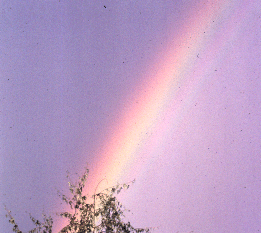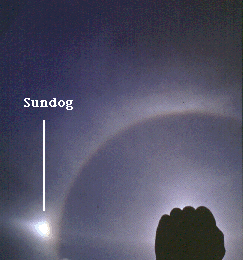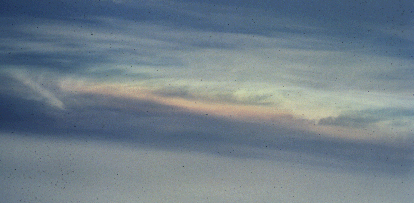Re: How do we see colours in clouds?
Area: Earth Science
Posted By: Jason Goodman, Graduate Student, Massachusetts Institute of Technology
Date: Wed Oct 15 08:38:29 1997
Area of science: Earth Science
ID: 875837644.Es
Message:
 There are several processes by which clouds can appear colored. The
most
familiar occurs when sunlight is reflected inside small spherical droplets
of water (rain or mist). Refraction occurs as the light enters and leaving
the raindrop, splitting the light into a spectrum which you see as a
rainbow.
There are several processes by which clouds can appear colored. The
most
familiar occurs when sunlight is reflected inside small spherical droplets
of water (rain or mist). Refraction occurs as the light enters and leaving
the raindrop, splitting the light into a spectrum which you see as a
rainbow.
 Sunlight can also be refracted through hexagonal needle-shaped
ice crystals in high-altitude or wintertime clouds. This makes a
(sometimes colored)
halo
around the sun, usually 22 degrees away from the sun. Often, air
currents in the clouds cause the needles to point straight up and down
rather than randomly. When this happens, only the parts of the halo
directly to the left and right of the sun are visible: these are called
"sun
dogs".
Sunlight can also be refracted through hexagonal needle-shaped
ice crystals in high-altitude or wintertime clouds. This makes a
(sometimes colored)
halo
around the sun, usually 22 degrees away from the sun. Often, air
currents in the clouds cause the needles to point straight up and down
rather than randomly. When this happens, only the parts of the halo
directly to the left and right of the sun are visible: these are called
"sun
dogs".
Finally, sunlight can diffract through cloud droplets. Imagine
ripples moving over calm water toward a rock, pier piling, or other
obstruction. The obstruction will scatter ripples in all directions.
Water droplets and haze particles will scatter light waves in the same way.
When the particles are much smaller than the wavelength, short waves are
scattered most strongly. This is what makes the sky blue. When the waves
are roughly the same size as the wavelength, the behavior is described by
Mie scattering theory. The behavior is very complex, with scattering being
a complicated function of direction and wavelength. Waves of a size
closely
matching the particles are strongly scattered, while waves slightly larger
or smaller pass through almost unchanged.
I suspect what you observed was some sort of Mie scattering. Usually,
water droplets in clouds are rather large (20-30 microns) compared to a
wavelength of light (.3 -.5 microns), so the Mie scattering spectrum says
that all wavelengths are reflected equally. This makes clouds appear
white. To form cloud droplets, water vapor must condense around tiny dust
particles called 'condensation nuclei'. Usually, there's lots of water
vapor but not much dust, so the drops are large.
Forest fire smoke puts lots and lots of these dust particles in the air.
If dust increases but amount of vapor stays the same, the average particle
size will be smaller. Smaller particles are closer to the size of a
wavelength of light, so the Mie scattering will be intense and wavelength
dependent. Some wavelengths (colors) will be strongly scattered, others
will pass right through to your eyes. Parts of the cloud with different
droplet sizes will filter different colors. Mie scattering polarizes light
strongly, so the effect will be more noticeable with polarized sunglasses.
Any fairly advanced book on optics or atmospheric radiation will have a
section on Mie scattering. Be warned: the math involved is fairly
high-level (calculus and differential equations)
For other readers: James Anderson, who originally asked the question, sent
me a note about a website with a picture similar to what he observed: the
site is at the
University of Illinois, and the picture is below.

Current Queue |
Current Queue for Earth Science |
Earth Science archives
Try the Earth Science links in the MadSci Library for more information on Earth Science .
MadSci Home | Information |
Search |
Random Knowledge Generator |
MadSci Archives |
Mad Library | MAD Labs |
MAD FAQs |
Ask a ? |
Join Us! |
Help Support MadSci
MadSci Network
© 1997, Washington University Medical School
webadmin@www.madsci.org
 There are several processes by which clouds can appear colored. The
most
familiar occurs when sunlight is reflected inside small spherical droplets
of water (rain or mist). Refraction occurs as the light enters and leaving
the raindrop, splitting the light into a spectrum which you see as a
rainbow.
There are several processes by which clouds can appear colored. The
most
familiar occurs when sunlight is reflected inside small spherical droplets
of water (rain or mist). Refraction occurs as the light enters and leaving
the raindrop, splitting the light into a spectrum which you see as a
rainbow.
 Sunlight can also be refracted through hexagonal needle-shaped
ice crystals in high-altitude or wintertime clouds. This makes a
(sometimes colored)
Sunlight can also be refracted through hexagonal needle-shaped
ice crystals in high-altitude or wintertime clouds. This makes a
(sometimes colored)
